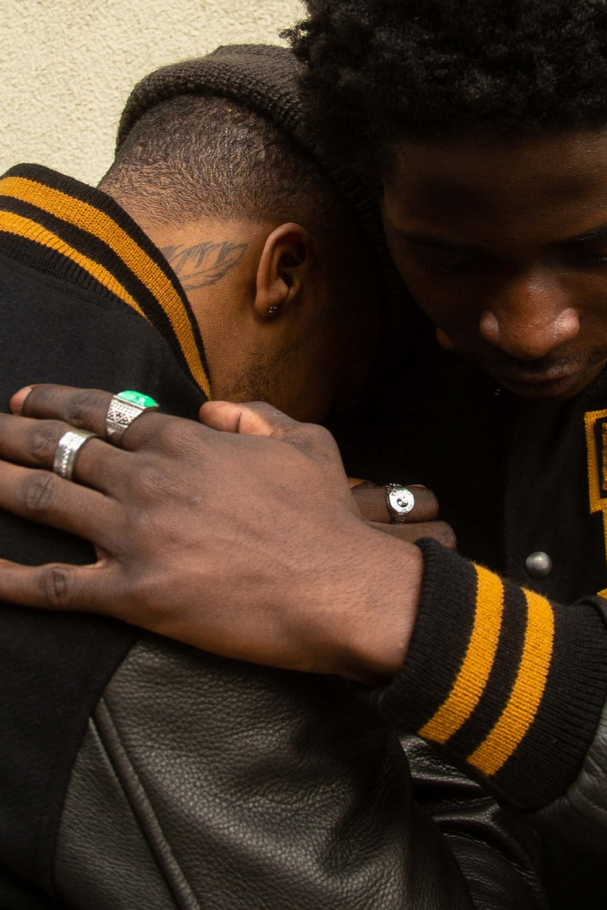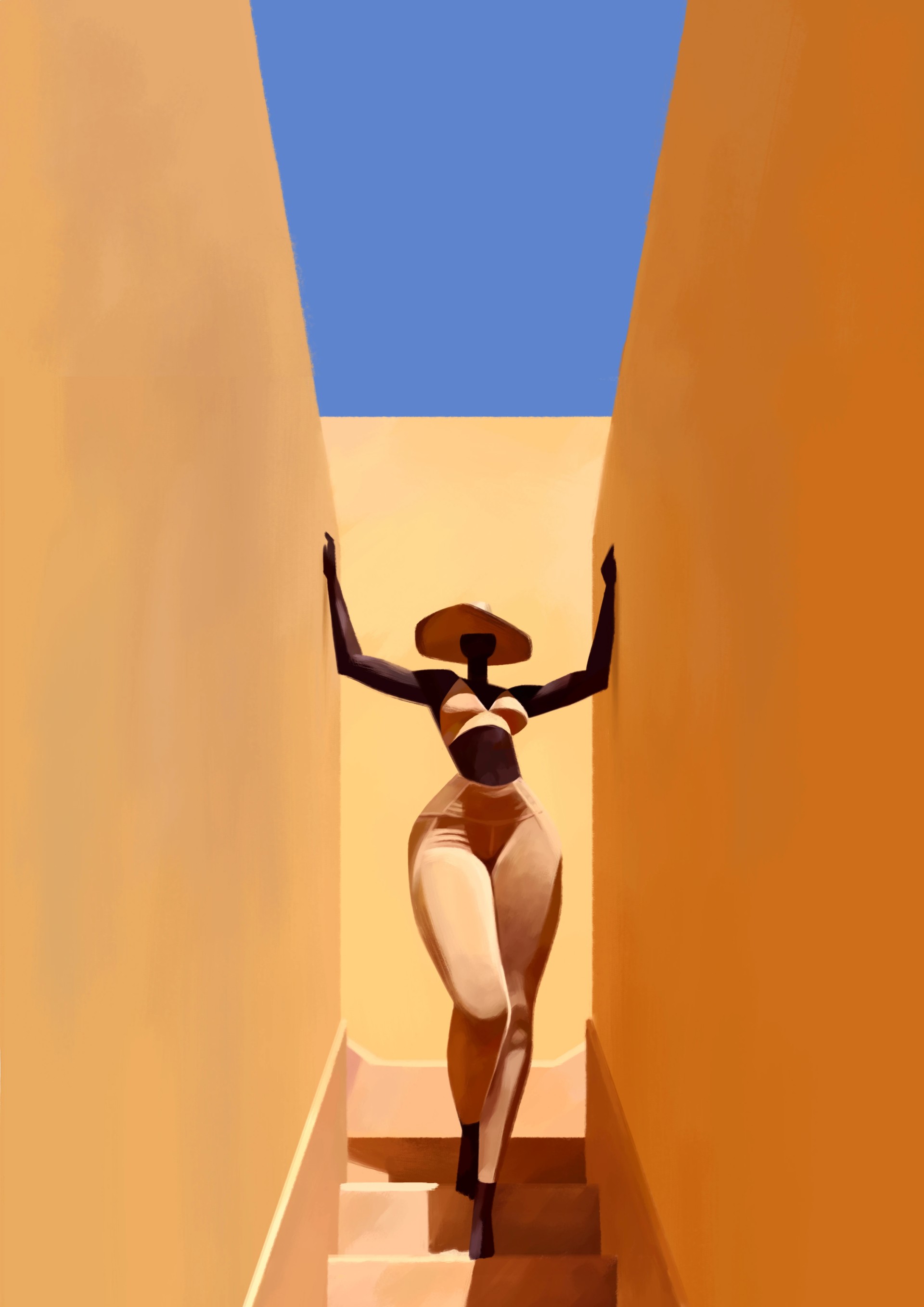
The Black Panther story you should know..
Illustration: Pierre Rutz
There is a graphic yet painterly feel to your work. Explain your design process. Are your paintings digital or actually painted on canvas?
I never paint on canvas with traditional mediums because I’m actually not that good a painter.
I’m only really good at three things; animating 2D characters which is my actual job, making kids (of which I have a lot…well 3, but during lockdown that does feel like a lot), and growing vegetables.
For my paintings I use Photoshop and a Cintiq (basically a big screen on which you draw directly with a digital pen). I always use a reference because I’m not great with colors and light, so what I do is look for a picture of a model that I feel would look cool as a painting and work from that.
The first part is a very rough sketch trying to simplify the silhouette as much as I can, working with the shapes to get to a nice balance of curves and straight lines, and push the contrast between big and small shapes as much as I can. Then comes the painting part. I use a brush that has a bit of texture to get that acrylic or pastel feel to it. I like the contrast of very simple shapes in the silhouette and the impression of volume that comes from painting with those brushes.
How did you come about your design style and your subject matter?
The subject matter came naturally to be honest. I’ve always liked curvy women, and I’ve always liked to draw them. At first, I really did those drawings just for me, but when I started posting them about 7 years ago I quickly started receiving messages from women thanking me for painting women with their body types and telling me that they made them feel better about themselves. So I never stopped.
My design style (which is something that is always evolving) comes from my influences. I studied character design for animation at a school called “Gobelins” in Paris.
So I was, of course, very influenced by animation from the start. That’s where I got the importance of simple but clear shapes because when you have to do hundreds of drawings for just a few minutes of animation, you had better not have a complex and very detailed character. That’s also where I learned the importance of balance between shapes, straight and curvy lines to get to an “appealing” design.
Some of my other influences, for these paintings in particular, are very varied…..from African tribal art, to 1940’s Soviet propaganda art with a bit of contemporary sculptors like Botero, or Carla Dijs, amongst many others.
What are some of the pushbacks you’ve received from viewers who question your intentions of painting full figured women?
I do get a lot of criticism, always along the same lines. The most common is the misinterpretation of the small faceless heads. Some people see it as a statement from me that women’s brains or minds are insignificant. The truth is that it is just a style born from the pursuit of pushing the contrast of shapes. It’s a style that is actually used by a lot of illustrators and sculptors. For me, the point of these paintings is to shine a light on curvy or plus sized women, so I emphasize that with exaggeration. ‘m not interested in realistic painting. I also don’t draw faces or just hints of it because I feel that it allows any woman to identify to the painting.
Another criticism I get is the “sexualisation of women” which I don’t really understand. I try, on the contrary, to paint strong confident women. I do paint big breasts and big butts, but that comes with the territory of painting plus size women. I also paint big arms, big bellies, big shoulders, big ankles, depending on what I feel looks cool on the particular painting. I don’t believe that painting a woman’s body is sexualizing her. A naked body is the most natural thing in the world. It’s what you do with that body that has to do with sex or not, and I don’t paint women in explicit poses.
The next one has to do with my relationship with the Body Positive Movement.
When I started doing these paintings the movement didn’t exist yet and it also wasn’t as fashionable to have a big butt then as it is today. Back then, I drew mostly women with big butts and slim waists. Some women were thanking me for those because it made them feel appreciated. Then, models like Iskra Lawrence and Ashley Graham started speaking out about body positivity so I started using the hashtag. The criticism I got after a while was that having a big butt and a small waist doesn’t qualify, and how dare I use the hashtag on anything other than paintings of plus sized women with big bellies or cellulite, etc. I received enough of those messages to stop using the hashtag except when I paint obviously big bellies, but it doesn’t really sit well with me because that is not at all how I see that movement. The way I see it is it says to ALL women with ALL body types that they are beautiful! Every woman is different and has her own insecurities, some struggle with their weight…..big or small, or height….tall or short, their hair, their skin, color, etc. So….I don’t really understand how my paintings or “UN-Body Positive”.
I sometimes get told that I don’t diversify enough. Why don’t you draw women with red hair? (which I’ve actually done more than once, but I guess they’re not red enough) Why don’t you draw women with glasses, or Black women with shaved heads? That gets me to a point where I’m asking myself who am I doing these paintings for? Myself, or the public? I do want to continue because I get heartwarming messages from women who tell me they feel much better about themselves when they see my paintings, and I want to go on for them. At the same time, my goal wasn’t and isn’t to represent every women in the world, every body type, every ethnicity, every hairstyle, etc… etc… etc… I understand that once I show my paintings to the public, people have a right to hold me accountable to a certain standard, but at the same time I’m not here trying to please everybody. I don’t have any issues with skin color because I love women of all ethnicities so that’s never a factor when I choose a reference. That being said, I do try to keep a certain balance in my posts even though I realize I haven’t painted a lot of Asian women.
Who are you inspired by?
I especially love illustrators from the 40’s-60’s even though it doesn’t really show in my work. I’m a big fan of Norman Rockwell and JC Leyendecker, and of course I love Duane Bryers’ Hilda character. I’m also very inspired by Spanish painters and illustrators. They really have their own style. Jose Luis Agreda for example is definitely one of my favorite illustrators, and then there are the modern day pin-up artists like Bill Pressing.







